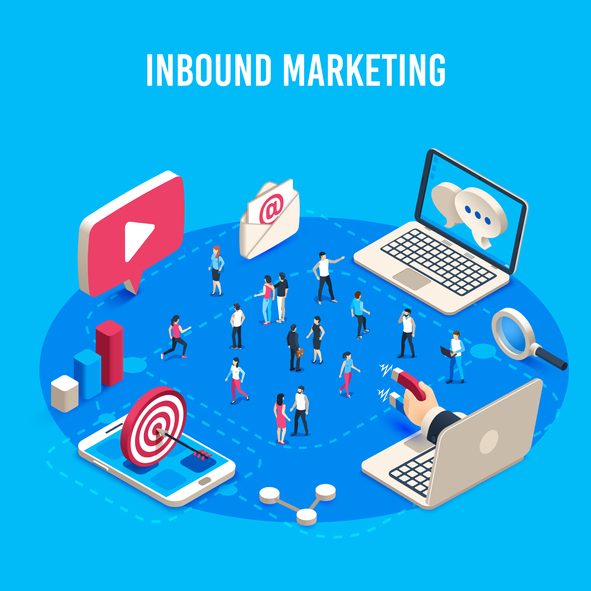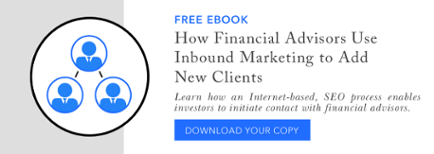Inbound Marketing for Financial Advisors: Why It Pays to Start Now!
Targeted inbound marketing is a great strategy for your financial advisor inbound marketing efforts. You want to land new clients but you also realize that certain old-school techniques are no longer working like they used to. It’s time to get savvy with your time and your money. As a financial advisor you want to spend the time and effort closing new clients not trying to find them. This is where inbound marketing comes into play. Rather than drowning in the deepwater of the internet trying to find a client, make the clients come to you. By providing useful information that your targeted client is interested in, they will come to you and your website.
The old ways of customer acquisition don’t work anymore. Dialing-for-dollars occasionally lets you get lucky. Chasing referrals is getting less and less effective, and cold-calling for financial planning clients is a fast track to another line of work.
The disadvantages of the old ways of doing business are many:
- Poor targeting. You’re going to spend a lot of time talking to people who are poor prospects for your services.
- It doesn’t add value. Most people don’t want to hear from you.
Past generations were accustomed to the Fuller Brush salesman or encyclopedia salesman visiting the home. There was a greater level of societal trust, and fewer demands on peoples’ time at home. But those sales practices have gone the way of the dinosaurs – and financial services sales and marketing practices from previous generations are rapidly going the same way.
Outbound marketing is becoming less and less effective.
Tomorrow’s wealthy and high-net worth clients are today’s young professionals, entrepreneurs and young parents. And they aren’t exactly jumping into the boat. They aren’t even biting at the same lures.
They’re more suspicious of financial service salespeople of all stripes. They don’t pick up the phone for callers they don’t know. They don’t even want to speak to a sales rep until they are well into the decision-making process. Until they are ready to buy, consumers prefer consulting a search engine to speaking to a live sales rep, 62% to 29%.
According to Gartner, by the year 2020, the average customer will manage 85% of their commercial relationships without even speaking to a human.
Inbound marketing is the increasingly prevalent practice of:
- Identifying your desired target market;
- Researching their wants, needs and pain points;
- Anticipating their online and media consumption behavior – including their search terms and the time of day they are most likely to check their email;
- Addressing their need or want on their schedule, not yours (dinnertime cold calling doesn’t work anymore);
- Convert them from readers/lookers into leads;
- Continuing to add value until they get in the boat (i.e., they become clients);
- Continuing to add value until they become brand missionaries, writing positive online reviews about you, and not only referring their friends and family and associates to you, but actively introducing you to them on a favorable basis.
When you reach that stage, you’re going to be too busy meeting clients and prospects to even think about cold calling. You’ll want all your marketing as automated as possible. Hiring a digital marketing firm that specializes in the financial industry will help you reach the next level.
But legacy marketing methods by themselves are increasingly unlikely to get you there.
- 90s-style Websites that function as nothing more than passive online brochures are hopelessly outdated.
- Websites that don’t add value are not going to turn prospects into leads.
- Websites that don’t quickly engage the reader are not going to give them a reason to give you their contact information.
- They’ll certainly have no reason to pick up the phone when you call.
It’s increasingly a national market, not a local one.
It’s great to have a home-town advantage. But increasingly, you’re not just in competition with the financial planner down the street. In today’s media environment, you are increasingly in competition with every financial planner in the country. Financial advisors, now more than ever, need to make sure they are ready to market themselves virtually.
Inbound marketing and its core component, content marketing, allows anyone anywhere in the country and beyond to get their lures in the water in front of your hometown clients. If they are doing a better job anticipating their wants, needs and search terms than you are, you may never have a chance. The battle for the client is lost, because you didn’t even drop a hook.
Inbound marketing is already routine. It’s already the norm. According to research from Hubspot:
- 79% of North American companies say they primarily do inbound marketing – a percentage that is fairly consistent throughout the developed world.
- 71% of all marketers believe their inbound marketing is effective.
- 53% say inbound marketing is generating a superior return on investment to outbound. Only 16% percent say their outbound marketing is doing better.
- Conversion rates are nearly 6x higher for content marketing adopters than non-adopters (Aberdeen).
The best indicator of how effective an aggressive inbound marketing effort is is how many people are maintaining and reinforcing success: 46% of marketers reported they increased their inbound marketing spend last year and another 32 percent held it steady.
Only 8% dialed it back.
Data from the 2019 Demand Generation Benchmark Survey confirms Hubspot’s findings: 71% of marketers surveyed said that their demand generation budget will increase in 2019. Of these, close to half (46%) said that their demand generation marketing budget will increase by 20% or more. That’s a marked increase from 32% in 2018.
This wouldn’t be happening if it wasn’t getting results.
In the B2B context, the average marketer is committing 26% of the marketing budget to content marketing, which is the foundation of inbound marketing. The most successful firms were committing much more – 40%. The least successful firms were spending an average of 14% on content.
Social Media is no longer cutting the mustard.
Social media is a good peripheral effort, and can help you get some more oomph out of your existing content marketing efforts. But you still need solid content to begin with. In 2017, straight search engine-generated traffic had resumed its place at the top of the traffic-generating hierarchy: 34.8% of all web traffic came from online search engines in 2017. Only 25.6% of traffic came from social media.
Furthermore, to be effective for lead generation, content has to be searchable. Your target market needs to be able to access it on demand, when they need it.
Lastly, social media effectiveness tends to suffer from self-imposed siloing. Google does not penetrate Facebook very well. You can have a great post or video on your Facebook page. But if it’s not put up on YouTube, Blogspot, WordPress or somewhere else that does a better job cooperating with outside search engines like Google, people are going to have a hard time finding it.
Don’t Market to Profiles, Market to Personas.
For an inbound marketing strategy to be effective, you have to identify your target market, and develop a detailed profile. And that requires more understanding than mere demographic data.
Sure, it’s nice to know age, sex, education level and profession. But demographics is just one dimension of targeting. That might get you to the profile level. But today’s most successful marketers aren’t marketing to profiles. They’re marketing to personas.
To turn a demographic profile into a persona, you need to go beyond the demographics of your target market and map out the psychographics as well:
- Hobbies
- Aspirations/goals
- Educational practices
- Values
- Fears
- Lifestyles
Research shows that developing personas and letting personas guide outbound and content marketing increases sales-qualified leads (SQLs) by 45%.
You don’t have to wait.
One great thing about qualify content marketing is that you can get started right away. You don’t need to wait until you have thousands to invest in building a top-of-the-line website (though that will almost certainly help, if it’s optimized to help you convert inbound traffic into actual leads).
You can start generating content that adds value for your target market right now. Blogging is an essential component of content marketing for most people. A great place to start is by creating a few blog posts that answer the top questions your best clients ask you early in their engagement with you.
Don’t go it alone.
But you’ll probably want to outsource this before long. It’s a simple matter time management:
The best, most productive use of any financial planner’s time is always to be meeting with new prospects, conducting fact finders and serving clients. Everything else is a non-core function and distraction, that should be delegated or outsourced.
Contracting the services of a firm like Paladin Digital Marketing may just be the best marketing money you will ever spend. Maybe it’s time to let the experts up your game!
In blogging, quality is king, but the quantity of quality matters a lot. Data from Hubspot shows that the most successful marketers blog a lot: Those who generate a blog post 16 times per month or more generate 4.5 times more leads than companies that published once per week or less.
Furthermore, longer, more detailed, more well-researched, value-added posts generate more value to the reader. They therefore tend to generate more leads. Many more leads. According to research from Curata, longer-form blog posts generate 9 times more leads than short posts.
The average blog post takes about 3 hours and 16 minutes to write. That number has been steadily increasing in recent years as marketers place more emphasis on establishing themselves as “thought leaders” in their respective fields. But for the optimal 16 blogs per month, that’s 52 hours per week of writing.
Most successful planners would rather be meeting with prospects and clients.
Get started now.
The best way to get started is to develop your business plan and develop several personas to market to. Identify and describe exactly who your perfect client is. And then free up your time by outsourcing content, automating, outsourcing and automating. The goal: Give yourself the time to follow up on your leads, meet with prospects who are ready to buy because of your great content marketing – and above all, serve your clients.


